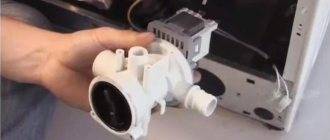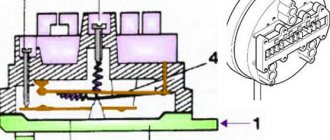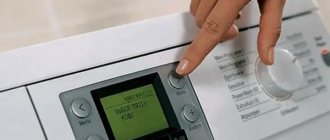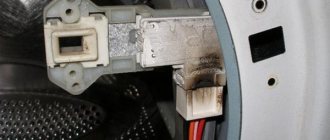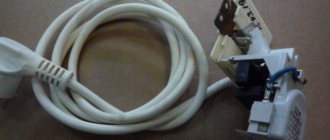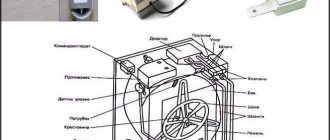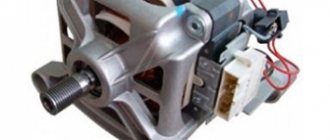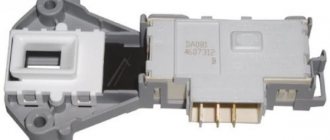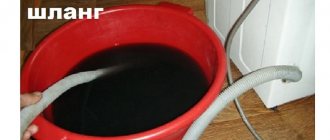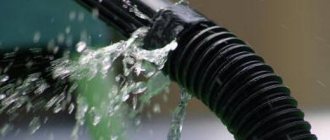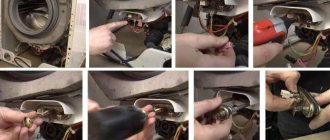Reasons for failure and their identification
If the washing machine does not drain water, then the reasons for such a breakdown can be very different. We list them in order of likelihood of their occurrence:
- The drain hose leading from the machine to the sewer is clogged. If a siphon is also included in this chain, then it can also become clogged with debris.
- Filter clogged. The filter can be blocked by coins, pebbles, paper, buttons and other items that were not removed from your pockets in time.
- Something has clogged the drain pipe, which is located between the washing machine tank and its pump. Example of a pipe clogged with debris
- If the washing machine does not drain water and is humming, then the pump responsible for pumping water has probably failed. It consists of an electric motor, a shaft with a plastic impeller and two pipes. The service life of the pump is about 5 years. Often, technicians disassembling the pump find threads and hair wound around the impeller shaft, which were the reasons for the failure. In addition to the engine burning out, the impeller may also break, but the entire assembly changes, in this case, entirely.
- Electronic control module malfunction. Its failure may occur due to power surges or due to natural wear and tear of electronic elements.
- The drain hose is too long. Over time, the power of the drain pump gradually decreases. Usually this power is enough to drain water through a standard hose about 1.5 m long. If a longer hose is used, then the pump may not be physically capable of pumping water over such a distance. Typically, such a failure occurs if the old machine is moved to another place, lengthening the drain hose twice or more. Drain hose of an automatic washing machine in a siphon
Many modern machines have digital displays that display not only operating modes, but also error codes that occur. Using these codes, using a special table in the instructions, you can determine the nature of the malfunction for more accurate diagnosis.
Some programs installed in washing machines may not provide a spin mode, so the machine waits for an additional command, pausing during the washing process. Therefore, if the washing machine does not drain the water and does not spin, then you need to make sure that the machine is set to the required operating mode.
We invite you to read why the dishwasher does not dry dishes well
How to get to the details
If the washing machine is automatic, then you will be able to check the serviceability of the drain pump without disassembling the housing. This applies to many modern models. Still, you have to follow the instructions to achieve the result. You must first disconnect the washing machine from the network and other communications. It is advisable to wear rubber gloves, as some parts may retain tension.
After this, you need to drain the water through a special filter, remove the powder container and lay napkins on the floor. The washing machine will have to be placed on its side if you need to check the pump without removing it.
Now you can look inside the body through the bottom of the car. The pump will immediately be in front of your eyes. It is located next to the drain pump housing, which is usually unscrewed and cleaned of dirt from time to time. It is usually not difficult to find the element of interest.
If the washing machine is equipped with a bottom in the form of a lid, then you will have to act a little differently. You will need to place the device on its side and take a Phillips screwdriver. With its help you will need to unscrew all the screws that support the bottom. The cover will need to be pryed off with a flat screwdriver and pulled off. There will be immediate access to the inside of the case.
Some devices have good protection against leaks. They have a special tray equipped with a sensor. A person will be forced to remove it to gain access to the machine's drain pump.
How to proceed:
- You will need to disconnect the device from the electrical network, sewerage and water.
- It is necessary to drain the remaining liquid from the tank using an emergency drain or a special filter.
- You will need to pull the Bosch washing machine away from the wall and lay napkins and a towel on the floor.
- Be sure to remove the powder container.
- Use a flat screwdriver to remove the pan latches. Now you can move it away to further disconnect the wire from the sensor.
- All that remains is to remove the pan and look at the parts that are inside the case.
As you can understand, checking the pump of a washing machine is not difficult. At the same time, you need to know what exactly indicates its malfunction.
Exploring the snail
If you hear an uncharacteristic hum in the area where the drain pump is located (and this is the lower right side of the housing), then a small object has probably gotten into the pump volute or a significant blockage is making itself known. Checking the pump of an ElG automatic machine will consist of the following:
- gain access to the garbage filter (it is located behind a small door located at the bottom of the front wall of the case);
- carefully unscrew the lid;
- shine a flashlight into the opened cochlea cavity and inspect it for the presence of foreign objects and blockages. In a normal situation, only the pump impeller should be visible inside.
After removing the debris and cleaning the cochlea cavity, you can screw the lid back to its original place and run the machine in test mode. Another common cause of loud noise from the pump area is a clogged inlet pipe. The hose must be cleaned with a special rod and rinsed under running water.
How to drain the water from the washing machine yourself?
If the automation refuses to drain the water, you will have to perform this procedure yourself. Let's look at how to drain water from a washing machine. There are several ways to do this. Choose the one that is most convenient for you and drain all the liquid from the tank:
- Unscrew the filter located on the bottom of the housing, first placing a water container under it. Tilt the machine towards the filter and fix it until the water drains. The container must contain all the water in the tank.
- If water does not flow through the filter, clean the pipe through which you drain the liquid. Sometimes it is enough to move the pipe slightly for water to flow out of it.
- In case of other failures, drain the water with a hose, simply lowering it into the tank of the washing machine, according to the law of communicating vessels.
Signs indicating pump failure
Before you start diagnosing the drain pump, you need to make sure that the problem really lies with it. Listen to the work of your “home assistant” and pay attention to external signs of problems. A pump malfunction is indicated by:
- the corresponding error code shown on the display;
- problems with draining water from the tank during the washing process and upon completion;
- failures to turn on/off the pump.
We talked about how to make a diagnosis. Remember that water leaving the tank irregularly is a sure sign of damage to the pump. By following the instructions, you can repair the machine yourself, without the help of a technician.
We suggest you familiarize yourself with the extra rinse icon on a bosch washing machine
Verification Process
Both the electrical and mechanical parts of the pump can fail. Many home craftsmen, forgetting about mechanics, rush to check the electrics, armed with a tester. But often the pump stops working due to debris.
Unfortunately, not all the debris goes into the drain filter - some of it can collect in the impeller area. Most often, hair and threads get wrapped around it, blocking the work over time. If you are thinking about how to check the pump without removing it from the engine, then we recommend removing it, especially since it is very easy to do:
- Take a photo or video of the wiring location. This will help you connect everything back correctly later.
- Remove the wiring.
- Unclench the clamps of the pipe and hose using pliers. Don't break them - they will be useful again.
- Turn the pump half a turn to the left and remove the part without any effort.
Related article: How to get rid of smell from a washing machine
Before disassembling the pump, carefully inspect the impeller. If you notice debris blocking its operation, start cleaning it. Be sure to thoroughly clean the entire pump to remove any accumulated dirt. Mechanics also include gaskets - they can wear out.
Important! Service centers do not advise repairing the pump, suggesting that it be replaced immediately. But the “traditional craftsmen” came up with a more economical way. They know how to lubricate the washing machine pump and use lithol or graphite lubricant.
If the mechanics are in perfect order, you can check the electrics. Proceed this way:
- Turn on the tester by selecting voltage test mode.
- Place the probes on the contacts.
- Does “0” or “1” appear on the display? The pump motor may have burned out - replace it.
- If a three-digit number lights up on the screen, then the problem may not be in the motor itself, but in the electronic control unit. More accurate diagnosis is required.
Now you know how to check the drain pump on a washing machine: disassembly is not essential, and checking will not take a lot of time. To make it easier, watch the video:
We will tell you how to properly check the pump in a washing machine, which will help you protect yourself and your assistant from a huge number of different breakdowns, and learn how to find and fix breakdowns of this nature yourself.
Troubleshooting steps
1. Disconnect the washing machine from the power supply.
2. Cleaning the filter. On the front side of the machine, at the bottom, there is a hatch under which the filter is hidden. It needs to be unscrewed and inspected. If it is clogged, it must be washed with water. If the cause of the problem was the filter, then when you unscrew it, water will flow from the pipe. To prevent flooding, you need to prepare a basin for water.
Cleaning the washing machine filter
3. If the washing machine still does not drain the water, what should I do? Checking the drain pipe. To disassemble it, you need to unscrew the fixing screws of the drain assembly. After this, the pipe is removed and checked. If it gets clogged in some place, you can feel the blockage with your fingers. After checking, the pipe is installed in its original place.
Drain pipe
4. Also, one of the reasons that the washing machine does not drain water may be that the impeller is jammed. It is located behind the filter. Often some small objects, as well as threads, get into it. Check if it rotates freely. To do this, scroll through it. If the impeller does not rotate, it means that it is jammed and will have to be freed from objects interfering with it. If it is not jammed, then the pump itself is likely to fail.
5. To diagnose the pump, you need to unscrew the filter and set the spin program in the washing mode selection menu. Use a flashlight to illuminate the drain hole. If the pump impeller is in a stationary position, then a breakdown of the pump should be suspected. A faulty pump needs to be replaced.
6. There are times when the pump impeller rotates during a dry spin, but the water does not drain. This type of malfunction is more typical for older units, the components of which are already quite worn out. Inside the pump, in a plastic cup, there are permanent magnets. The glass is protected from water getting on the magnets by a cuff located on the shaft. When voltage is applied to the pump winding, the permanent magnets begin to rotate, causing the rod to move.
If the sealing collar is damaged, then water begins to seep into the glass, and with it dirt. As a result, the magnets cannot work fully, and the pump jams in spin mode. In addition, over time, the magnets themselves can gradually demagnetize, which also leads to a decrease in pump power. A sign of such a malfunction is the noise emitted by the pump. In this case, the pump itself does not work, but only makes noise.
We suggest you familiarize yourself with How to clean the filter in a washing machine: where it is located and how to remove it
How to find a pump
Before checking whether the pump is working or not, you need to find its location. Often the design of the machine allows you to see the part without even opening the case. Proceed as follows:
- Disconnect the machine from the water supply, sewer pipe and unplug the power cord.
- Remove the powder dispenser.
- Cover the floor with a cloth.
- Lay the machine on its side.
- If your model does not have a bottom, then everything is simple - the pump will be in the public domain right in front of you. It is located opposite the drain filter (this is what you check and clean every 3 months). In general, this detail is difficult not to see or confuse.
- If there is a bottom, then it must be removed by unscrewing the fastenings with a Phillips screwdriver. Use a second screwdriver to pry up the bottom.
Related article: How to remove odor in a washing machine
If your washing machine is 100% protected from leaks by the manufacturer, then before checking the pump in the washing machine, you need to remove the special tray and sensor. To get to the pump in this case, you need to act like this:
- Disconnect the SMA from the outlet, from the sewer and water pipes.
- Drain the water using the emergency drain tube (located near the filter) or drain filter.
- Move the equipment to the center of the room and lay down a cloth.
- Take out the detergent dispenser.
- Drain the water through a hose or filter at the bottom of the housing.
- Place the machine on its side.
- Pry and pull off all the latches on the pallet (usually there are four).
- Move the pan aside to remove the wiring going to the sensor. The sensor itself is attached to the pallet.
Important! The sensor you will see on the pallet is a leakage sensor. It is triggered when water enters the pan. It is he who, having detected a leak, blocks the operation of the machine, stops the flow of water, and prevents a “universal flood” in the apartment.
Removing the pan, you will see what you were looking for - the drain pump.
How to change the pump yourself
One of the most difficult failures, in which the washing machine has stopped spinning and draining water, and is also humming, is a pump malfunction. In this case, it will most likely need to be replaced.
Washing machine pump
Let's look at the procedure for replacing the pump:
- The drain assembly must be removed.
- The drain pump is detached from the drain assembly.
- The wires that go to it are removed from the pump.
- A new unit is installed in place of the old pump.
- Wires are connected to the new pump.
- The drainage unit is installed in its place.
- The machine is connected to the network and a test wash is performed.
- If the washing machine continues to drain water poorly, contact customer service.
Replacing a washing machine pump
In the best case, of course, replace it with exactly the same one. But if the original cannot be found, then an analogue is selected based on the characteristics.
A replacement pump is selected based on the following criteria:
- Electrical power in watts.
- Method of fastening the snail: latches or self-tapping screws.
- Number of latches or fastening points for screws.
- Electrical connection: chip or terminals - together or separately, front or rear.
Pumps of Chinese and Italian production Leili, Askoll, SKL, Copreci are interchangeable - subject to the characteristics and characteristics.
In modern automatic washing designs, checking the pump is not a difficult task, but not everyone does it correctly. There have been cases when owners changed working drain pumps, spending a lot of time and money, and still the problem did not go away, which hinted at the breakdown of a completely different element of the washing machine.
Rules for the operation and prevention of the washing machine
To ensure that your washing machine serves trouble-free for many years, we advise you to follow some simple recommendations:
- Each washing machine model is designed for a certain weight of laundry loaded into it. If this weight is exceeded, the unit will wear out. In this case, the likelihood of failure increases many times over.
- There is always some kind of garbage in the pockets of the laundry loaded into the tank. These could be pins, paper clips, coins, headphones, pieces of paper, etc. Any of them can damage the pump, impeller, or motor. Remember to inspect all clothing before loading.
- It is better to connect the machine to the power supply not directly, but through a special surge protector. It smoothes out voltage surges, which are not uncommon in our networks. Small jumps are not harmful to the washing machine, since this is provided for by its design, but large differences can lead to damage to the electronic unit.
- Do not forget to regularly clean the filter located under the hatch on the front wall. This should be done annually, or even better - every 6 months. If the filter is clogged, this may be one of the reasons why the washing machine does not drain water.
- Before starting washing, carefully set the required mode.
- Carry out preventive cleaning of the machine every year without laundry. To do this, you need to load the powder and descaling agent, set the highest temperature and carry out a full wash cycle. As a result, scale and dirt will be removed.
By using these simple tips, you will be able to use your washing machine for its intended purpose for many years.
